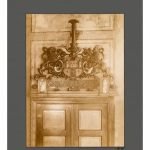Introduction
White woodwork paint is a versatile and attractive product for any home improvement project. It offers a crisp, clean look and can give your home an updated and sophisticated feel when used correctly. White woodwork paint is ideal for trim, moldings, baseboards, stairs, window frames, shelving/cabinets, furniture and more. When properly applied it can make wood surfaces look beautiful even through the wear and tear of daily life.
White woodwork paint provides extensive benefits, including enhanced durability against damage such as chipping or peeling. This type of paint is also easy to clean because it resists dirt and stains more efficiently than other paints, making it easier to maintain sought-after looks in all areas of the home without spending lots of time or effort on upkeep. Furthermore, white woodwork paint comes in a variety of textures and finishes so you’re sure to find the perfect style for every room in your house.
The advantages of white woodwork paint makes it suitable for various types of wood, including hardwoods (such as cherry and maple) that might require some extra care when painted in darker colours. White can be used to lighten up dark or damp spaces such as basements or attics where brightening up space may be beneficial. Additionally if you have certain designs on the flooring – rugs or carpets – white puts the focus on colour rather than the overall design pattern which can often be lost with darker paints.
Different Types of White Woodwork Paint
White woodwork paint can come in several different varieties, depending on the desired finish. Gloss paints provide the highest level of shine and are often used in situations where surface brightness is desired, such as on window trim or cabinetry. Satin paints offer a softer sheen that may be more appropriate for furniture or shelving. Flat white woodwork paint gives off only a minimal amount of shine and is ideal for areas that do not need to have a bright glint, such as interior walls. Milk paint is a type of white paint that has a very simple design and texture and was historically used for outdoor applications due to its durability. This rustic look makes it popular in modern décor as well, so it’s worth considering for any room of the home.
Best Painting Technique for White Woodwork Paint
Preparing the Surface:
Before beginning any type of painting project on white woodwork, it is extremely important to properly and thoroughly prepare the surface first. This includes cleaning the entire area with a mild soap and water solution and backing up with a fine-grit sandpaper to make sure all surfaces are smooth. If there are any stains or blemishes, fill them in using putty before continuing to the next step.
Applying the Paint:
Once the surface has been prepared, it is time to start applying the paint. Start by using a roller or brush to apply at least two coats of primer. Allow each layer of primer plenty of time to dry completely before proceeding with the application of actual paint color. Be sure that you cover any visible gaps or imperfections with further coats as needed so that there will be no visible inconsistencies once it is finished.
Giving It Time To Dry:
After all layers have been applied, allow adequate time for drying. This can range from 24-72 hours depending on environmental factors, so it is important to ensure that your workspace has proper airflow and let it sit until completely dry before touching it or sealing it further down the road. Doing this will guarantee that your freshly painted woodwork will last for years and look new even after years of use
Tips for Achieving a Professional Look with White Woodwork Paint
Sanding: Sanding the woodwork is key to achieving a professional, smooth finish. Before you begin painting, start by removing any imperfections from the surface. Make sure to sand in all direction as this will ensure a uniform finish without any rough patches. This can be done with a piece of fine-grit sandpaper or an electric sander if you have one.
Priming: After sanding the woodwork, the next step is to prime it with a sealant. Primer is essential for ensuring that paint lays down evenly on the wood and acts as a base for your white woodwork paint. When selecting primer, choose an oil-based one specifically designed for interior surfaces and diluted with water in order to make it easier to apply. Make sure to roll the primer rather than Brush it on for greater coverage and a smoother finish.
Taping Edges: Prepping white woodwork paint also includes taping off your edges before you begin painting. Masking or painter’s tape should be used to line areas where two different colors or textures meet such as trim around doors or windows and around moldings. This will prevent any bleed through of color or texture which can negatively impact desired look of the finished product.
Other Special Features of White Woodwork Paint
Durability: White woodwork paint is highly durable, resistant to chipping and cracking. It also resists fading even when exposed to direct sunlight for a long period of time. In addition, it is waterproof, which helps protect the wood from any potential water damage.
VOCs: The low VOC content of white woodwork paint helps keep your indoor air quality clean and safe for people who are in the space. It does not produce toxic chemical off-gassing that can result in irritation or other health issues for those in the space.
Certifications: White woodwork paint is certified by industry standards such as Greenguard Gold, National Green Building Standard, California department of Public Health Air Resources Board, and Oeko-Tex® 100 standards. This ensures that it meets strict safety standards in terms of emissions and environmental impact.
How to Get the Most Out of Your White Woodwork Paint Experience
Choosing the Right Product: When selecting a white woodwork paint, there are several factors to consider. Check for quality and durability by checking reviews from customers and doing research on the brand you’re considering. Consider your project goals in terms of aesthetic finish needed and the level of protection desired. For example, if you need a paint that is resistant to fading or water damage, be sure to select a product with those properties. If you are looking for a shinier finish, then choose a high-gloss paint that will offer more glossy sheen than flat paints.
Applying It Properly: Proper preparation before painting is essential in order to ensure adhesion and longevity of the coating. Begin by thoroughly cleaning the surface with soap and water and then sanding it smooth so that any bumps or uneven surfaces are leveled out. Use protective gear like goggles and gloves when handling any potentially hazardous material like sandpaper or cleaners. Priming wood prior to painting can help reduce your chances of having uneven coats of paint and provide additional protection against moisture damage. Always use a quality brush or roller to apply your white woodwork paint, as poor application will lead to an unsatisfactory final product.
Finishing: Once the white woodwork paint has been applied evenly, it’s time for finishing touches like edging and trim work that give rooms character and dimensionality. Finishing supplies such as caulk can help fill gaps between boards or trim pieces, giving you a smooth integrated look when finished painting. Look into adding stain if desired, followed by varnish if gloss is desired without sacrificing resistance against water damage or fading over time due to UV exposure. Chalk may also be used to create interesting patterns throughout your design if so desired – just make sure not to go overboard!
Maintenance: Taking proper care of white woodwork painted surfaces helps maintain their beauty while extending their lifespan manyfold. Regular cleaning using only mild detergents ensures that dust doesn’t accumulate on the surface which can degrade its overall appearance over time t if not addressed promptly . Touching up small nicks or scratches as soon as they occur prevents larger areas from needing repair down the line since these imperfections tend to draw attention away from other elements in their surrounding environment . Waxing treated surfaces occasionally can help further protect them from everyday wear-and-tear as well as provide extra shine , making them look new again everytime . With special attention paid through these methods , white wooden painted surfaces will remain strong and beautiful long after initial application .
Examples of Successful White Woodwork Paint Projects
White woodwork paint projects can be a great way to make a home look more modern with a fresh, bright, and inviting aesthetic. For example, painting an outdated kitchen with white woodwork can not only create a more vibrant and energetic atmosphere but also create the illusion of additional space. Painting wood walls, ceiling beams, and trims in an open-plan living room with white will both unify the different levels of the space and give it an airy feeling.
If you’re looking to brighten up dark interiors or trying to make a small bedroom feel larger, painting wainscoting or installing trim to separate walls in thick matte white paint might be just the solution. White wall paneling paired with modern furniture brings texture and sophistication to any house; perfect for creating cozy yet contemporary living spaces.
For bedrooms needing an extra bit of warmth, complement light timber floors and a neutral palette with brush-painted skirting boards and architraves in creamy ivory finishes. On the other hand if you’re aiming for a minimalistic look opt for hi-gloss whites as they best convey contemporary vibes that work wonders by making compact rooms appear much brighter than they actually are.
Equally important is paying attention to details when applying finish coats on wooden elements: using glossy paints will outline all uneven surfaces highlighting imperfections so go for semi-gloss at least which adds depth without taking away from subtlety. When it comes to decorative effects some herringbone patterns or block sections painted with shadows can really bring out allure of many residential projects whilst adding character as well!
Final Thoughts
White woodwork paint is becoming increasingly popular due to its ability to quickly and easily transform wooden surfaces. This type of paint is versatile, making it an ideal choice for a wide range of furniture and accessories, whether indoors or outdoors. The sleek and modern finish provides a clean look which can make a dramatic difference in the overall look of any room.
One of the main advantages that white woodwork paint has to offer is its durability; when applied properly, it can stand up against wear and tear from day-to-day use, making it a good option for high traffic surfaces like chair rails, door frames, window frames, and more. It’s also very easy to apply; even those with little painting experience can achieve professional-looking results with just a few simple steps. Furthermore, it does not require special skills or tools for application ” all you need is sandpaper, primer, and white paint!
However, there are some drawbacks that should be noted before taking on a painting project using white woodwork paint. Firstly, this type of paint tends to be more vulnerable to fading than other colors when exposed to sunlight. Additionally, if poor quality paints are used they could chip or peel off over time. Finally, as with all types of painting jobs proper upkeep requires periodic repainting or resealing in order to keep it looking brand new.
Despite these potential drawbacks though ” white woodwork paint remains one of the most popular options today due its many benefits like affordability and ease of application ” not to mention how effortlessly stylish it can make almost any space feel!

Hi everyone! I’m a woodworker and blogger, and this is my woodworking blog. In my blog, I share tips and tricks for woodworkers of all skill levels, as well as project ideas that you can try yourself.





